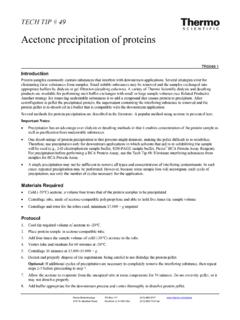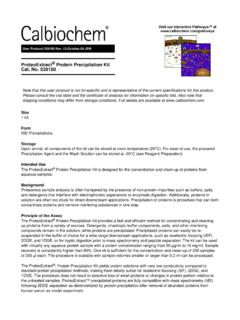Transcription of 2. TCA/Acetone Protein Precipitation Protocol
1 Proteomics and Mass Spectrometry Facility, BRC, Cornell University Version 2. TCA/Acetone Protein Precipitation Protocol The following procedure is used to precipitate proteins from freshly prepared cell lysates containing some contaminants, such as salt, detergents, nucleic acids, and lipids that can interfere with the subsequent 2D analysis. TCA/Acetone Precipitation is one of the most common Precipitation methods. The acetone used in this procedure should be pre-chilled and stored in a -20 C freezer until needed and kept on ice during the entire procedure. Procedure 1. Mix the following solutions in a 1:8:1 ratio in the following order (invert tube after adding each component): 1 ml cell lysate 8 ml 100% ice-cold acetone 1 ml 100% trichloroacetic acid (100%TCA, w/v) 2.
2 Precipitate at -20 C for 1 hr. 3. Centrifuge at 11,500 rpm (18,000 x g) for 15 min at 4 C in a microcentrifuge. 4. Discard supernatant. Wash with 1 ml ice-cold acetone (resuspend pellet completely). Centrifuge at 11,500 rpm for 15 min at 4 C. 5. Repeat step 4 twice to remove all of the TCA. 6. Remove all acetone and let the pellet dry at room temperature. The presence of residual acetone will make sample resuspension more difficult. 7. Store the pellet at -20 C for late use. 8. Or dissolve the Protein pellet in the appropriate volume of 2-D rehydration buffer by repeatedly pipetting up and down to break up the pellet. 9. Allow sample to sit at room temperature for 1 hr, vortexing approximately every 10 min.
3 10. Transfer to Eppendorf tube and centrifuge at 14,000 rpm for 10 min at room temperature. Immediately transfer the supernatant into a new Eppendorf tube. Store at -80 C until ready for use. Discard pellet.









